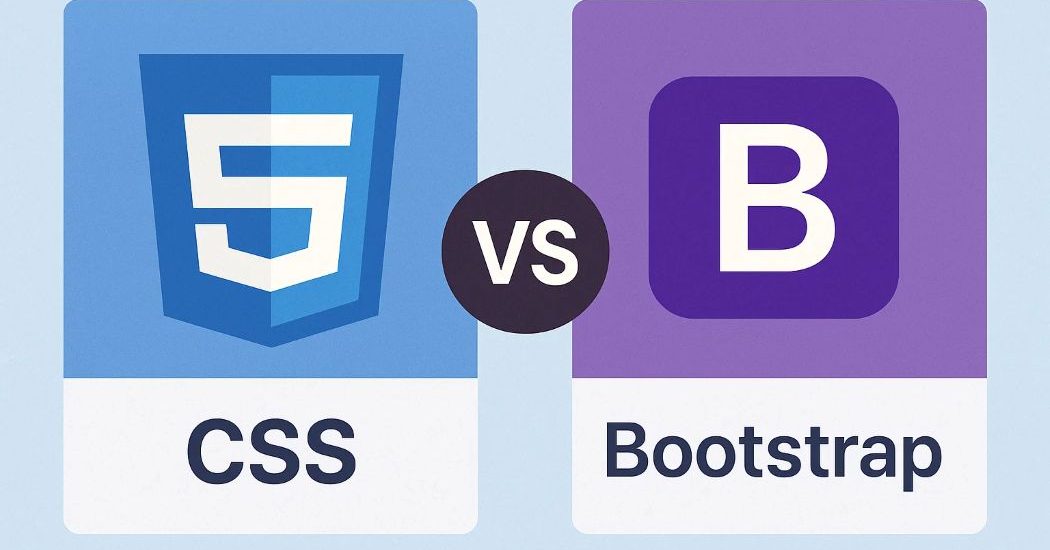CSS remains a foundational skill in 2025, especially for building modern, responsive, and fast-loading websites. Yet, many developers still face a common dilemma: stick with plain CSS for full control or use a framework like Bootstrap for faster development?
While both CSS and Bootstrap help style websites, they serve different purposes. This blog will break down the differences, advantages, and best use cases for each in today’s fast-changing web development landscape.
🎯 What Is CSS?
CSS (Cascading Style Sheets) is the core styling language of the web. It gives developers full control over the look and feel of a website, from colors and fonts to spacing, animations, and responsiveness.
✅ Key Features of CSS:
- Complete customization
- Precise control over every element
- Optimized for performance
- Works with any framework or platform
- Native to all browsers—no extra files required
Using raw CSS allows you to build your design from scratch, ensuring clean, minimal, and tailored layouts.
🚀 What Is Bootstrap?
Bootstrap is a popular front-end framework developed by Twitter. It uses pre-built classes and components to help developers quickly build responsive, mobile-first websites.
✅ Key Features of Bootstrap:
- Built-in responsive grid system
- Pre-designed UI components like buttons, modals, and forms
- Cross-browser compatibility
- Easy integration with JavaScript and jQuery
- Speeds up development for beginners and teams
Bootstrap is ideal when you need to create a polished layout fast without designing every detail manually.
🆚 CSS vs Bootstrap: Head-to-Head Comparison
| Feature | CSS | Bootstrap |
|---|---|---|
| Learning Curve | Steeper (more flexible) | Easier for beginners |
| Customization | Full control | Limited (without overriding classes) |
| Speed of Development | Slower (manual work) | Faster (pre-built components) |
| File Size | Lighter (if optimized) | Heavier (includes lots of extra code) |
| Design Consistency | Developer-dependent | Consistent out of the box |
| Responsiveness | Manual media queries | Automatic with grid system |
| Use Case | Custom projects, brand-specific sites | MVPs, prototypes, admin dashboards |
🧠 When to Use CSS in 2025?
You should choose raw CSS when:
- You want a unique, brand-specific design
- You need maximum control over UI elements
- You aim for performance optimization
- You work on smaller-scale or lightweight projects
- You are building complex animations or transitions
CSS continues to evolve in 2025, with features like CSS Grid, Flexbox, and :has() selectors making layout control easier than ever.
⚡ When to Use Bootstrap in 2025?
Bootstrap works best when:
- You need to build quickly
- You’re creating internal tools or dashboards
- You want consistent UI elements without design effort
- You’re working in teams or collaborative projects
- You lack dedicated UI/UX designers
Bootstrap 6 (the latest version in 2025) includes Cascading Style Sheets variables, improved accessibility, and utility-first design tweaks—making it even more developer-friendly.
💡 Can You Use Both Together?
Yes! Many developers combine the two. Bootstrap handles the layout and components, while custom CSS tweaks the appearance. Just be cautious of code bloat—loading both may impact performance if not managed well.
Tip:
Use Bootstrap for layout and base styles, then add CSS selectively to override or enhance parts of the UI.
🧩 Developer Preference in 2025
In 2025, developers tend to choose based on:
- Project scope
- Team size
- Time constraints
- Design complexity
For enterprise or brand-driven sites, Cascading Style Sheets still rules. For prototypes, admin panels, and internal tools, Bootstrap remains the go-to.
📌 Final Verdict: CSS or Bootstrap?
There’s no one-size-fits-all answer.
- Choose CSS for full customization, better performance, and unique designs.
- Choose Bootstrap when you need speed, consistency, and ease of use.
Your project’s goals should guide your choice—not trends.
Whether you’re building a portfolio, SaaS dashboard, or eCommerce site, understanding when to use Cascading Style Sheets or Bootstrap will save time, improve quality, and boost your workflow.





